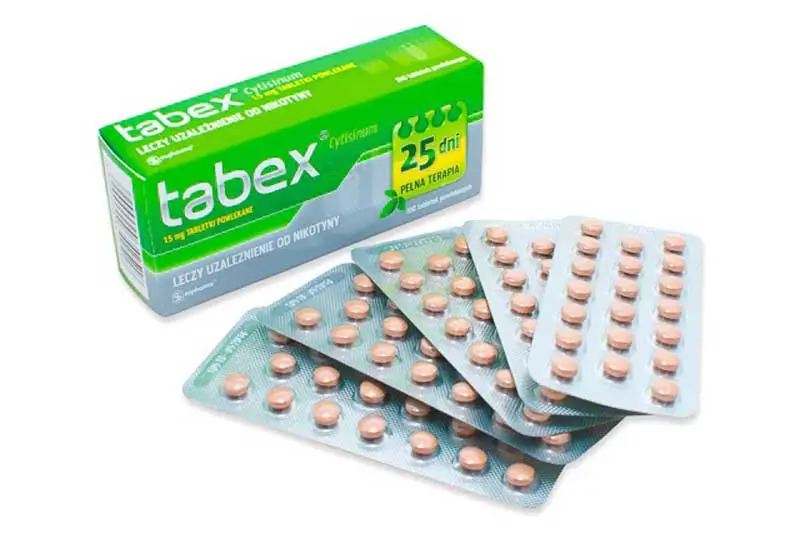Cytisine: An Effective Solution to Quit Smoking
Cytisine is a plant-derived molecule that has been used since 1967 in Eastern European countries as a treatment to quit smoking. Recent randomized studies have shown that it is an effective and safe active ingredient. Known for its effect on nicotine receptors, cytisine is one of the most extensively studied solutions in smoking cessation therapy.
Although its origins lie in Eastern Europe, cytisine-based treatments are now available in many countries, including Canada and New Zealand, where it has been enthusiastically embraced by healthcare professionals and patients seeking a reliable method to quit smoking.
Cytisine for Smoking Cessation: History and Origins
Cytisine, a natural alkaloid found in many plants of the Fabaceae family, is primarily extracted from the laburnum tree (Laburnum anagyroides or Cytisus laburnum L.), also known as “false tobacco.” During World War II, the leaves of this plant were used as a tobacco substitute and were called “fake tobacco” by Russian soldiers.
Over time, cytisine has been the subject of numerous scientific studies, confirming its ability to help smokers overcome addiction. In 1978, cigarette manufacturers recognized its potential, noting that cytisine’s pharmacological action closely resembles nicotine’s without the harmful effects of tobacco. This led to its commercialization under well-known names such as Tabex®, Desmoxan®, Cravv®, and Todacitan®, making it an important tool for those seeking an effective smoking cessation therapy.
How Cytisine Works to Help You Quit Smoking
Cytisine acts as a partial agonist of the nicotine receptors in the brain, the same receptors to which nicotine from tobacco binds. This mechanism:
- Reduces nicotine withdrawal symptoms, such as irritability, anxiety, and difficulty concentrating.
- Decreases the pleasure and gratification derived from smoking, especially in the early days of treatment.
- Helps smokers overcome addiction without resorting to nicotine substitutes, offering a more natural approach to quitting.
A key feature of cytisine is its ability to block the “reward” sensation associated with smoking. This means that even if a smoker continues to smoke during the initial days of treatment, the gratifying effect will be significantly reduced, making it easier to quit. Recent studies have shown that cytisine can be more effective than traditional therapies, such as nicotine patches or gums.
Dosage and Treatment with Cytisine
A typical cytisine treatment lasts about 25 days, during which the dosage is gradually reduced. A standard Tabex® regimen includes:
- Days 1 to 3: 6 tablets per day.
- Days 4 to 12: 5 tablets per day.
- Days 13 to 16: 4 tablets per day.
- Days 17 to 20: 3 tablets per day.
- Days 21 to 25: 1-2 tablets per day.
This progressive schedule allows the body to gradually adapt to the absence of nicotine, minimizing withdrawal symptoms. In cases of side effects such as nausea or dizziness, a slower approach can be adopted under medical guidance. Thanks to its low cost, cytisine treatment is affordable and represents an economical alternative to other therapies.

Side Effects of Cytisine: What to Know
While cytisine is generally well-tolerated, side effects may occur, particularly at high doses. Common side effects include:
- Nausea and vomiting.
- Headaches and heartburn.
- Dizziness and muscle weakness.
- Tachycardia and digestive disturbances.
To minimize these effects, it is advisable to start with lower doses and gradually increase. Additionally, it is always important to consult a doctor before starting therapy, especially if you have pre-existing medical conditions.
Benefits of Cytisine for Smoking Cessation
Cytisine offers several advantages over traditional therapies:
- Proven effectiveness: Clinical studies have demonstrated that cytisine is more effective than nicotine replacement therapies.
- Lower cost: Cytisine treatment costs 5 to 10 times less than nicotine patches or gums.
- Reduction of withdrawal symptoms: Its effect on nicotine receptors makes quitting smoking more manageable.
- Natural approach: Extracted from a plant, it is a less invasive solution compared to synthetic drugs.
Precautions and Contraindications for Cytisine Use
Cytisine should be used with caution in patients with pre-existing conditions such as:
- Chronic heart failure or cerebrovascular diseases.
- Diabetes mellitus or hyperthyroidism.
- Gastroesophageal reflux or peptic ulcers.
Cytisine is contraindicated during pregnancy, breastfeeding, and in patients with known hypersensitivity to the active ingredient. Consulting a doctor is always necessary before starting treatment.

Conclusion: Cytisine as a Natural and Affordable Solution to Quit Smoking
Cytisine stands out as one of the best natural smoking cessation remedies, offering a safe, effective, and affordable alternative to traditional therapies like nicotine patches or gums. By acting directly on nicotine receptors, cytisine reduces withdrawal symptoms and diminishes the reward sensation linked to smoking.
This natural approach, derived from plants, provides an accessible path to overcoming addiction without synthetic chemicals. For smokers seeking a cost-effective and proven method to quit, cytisine offers a compelling solution supported by extensive studies and real-world success. Consult your doctor today to explore how cytisine can help you break free from nicotine addiction and start a healthier, smoke-free life.
Sources and references
- Inc Zpharm. Now available: new over-the-counter natural product promises to make quitting smoking easier for millions of Canadians. eNewswire News Room. Published 8 July 2017 (accessed 29 September 2018).
- Hajek P, McRobbie H, Myers K. Efficacy of cytisin in helping smokers quit: systematic review and meta-analysis. Thorax. 2013 Nov;68(11):1037-42 . Epub 2013 Feb 12. PMID: 23404838
- Tutka P, Vinnikov D, Courtney RJ, Benowitz NL. Cytisin for nicotine addiction treatment: a review of pharmacology, therapeutics and an update of clinical trial evidence for smoking cessation. Addiction. 2019 Nov;114(11):1951-1969. doi: 10.1111/add.14721 . Epub 2019 Jul 19. PMID: 31240783
- Zatonski, Witold & Janik-Koncewicz, Kinga & Stępnicka, Zuzanna & Zatońska, Katarzyna & Połtyn-Zaradna, Katarzyna & Herbec, Aleksandra. (2020). History of smoking cessation treatment in Poland – the strengthening role of cytisin as the most effective and safe pharmacotherapy. Journal of Health Inequalities. 6. 116-123. 10.5114/jhi.2020.102969 .
- Courtney RJ, McRobbie H, Tutka P, Weaver NA, Petrie D, Mendelsohn CP, Shakeshaft A, Talukder S, Macdonald C, Thomas D, Kwan BCH, Walker N, Gartner C, Mattick RP, Paul C, Ferguson SG, Zwar NA, Richmond RL, Doran CM, Boland VC, Hall W, West R, Farrell M. Effect of Cytisin vs Varenicline on Smoking Cessation: A Randomized Clinical Trial. JAMA. 2021 Jul 6;326(1):56-64.
- Walker N, Smith B, Barnes J, Verbiest M, Parag V, Pokhrel S, Wharakura MK, Lees T, Cubillos Gutierrez H, Jones B, Bullen C. Cytisin versus varenicline for smoking cessation in New Zealand indigenous Māori: a randomized controlled trial. Addiction. 2021 Mar 24. doi: 10.1111/add.15489 . Epub ahead of print. PMID: 33761149
- Nides M, Rigotti NA, Benowitz N, Clarke A, Jacobs C. A Multicenter, Double-blind, Randomized, Placebo-controlled Phase 2b Trial of Cytisinicline in Adult Smokers (The ORCA-1 Trial). Nicotine Tob Res. 2021 Apr 13:ntab073. doi: 10.1093/ntr/ntab073 . Epub ahead of print. PMID: 33847362
- Pastorino U, Ladisa V, Trussardo S, Sabia F, Rolli L, Valsecchi C, Ledda RE, Milanese G, Suatoni P, Boeri M, Sozzi G, Marchianò A, Munarini E, Boffi R, Gallus S, Apolone G. Cytisin Therapy Improved Smoking Cessation in the Randomized Screening and Multiple Intervention on Lung Epidemics Lung Cancer Screening Trial. J Thorac Oncol. 2022 Jul 28:S1556-0864(22)00346-X. doi: 10.1016/j.jtho.2022.07.007 Epub ahead of print. PMID: 35908731
- Walker N, Howe C, Glover M, McRobbie H, Barnes J, Nosa V, Parag V, Bassett B, Bullen C. Cytisin versus Nicotine for Smoking Cessation. N Engl J Med 2014.
Leaviss J, Sullivan W, Ren S, Everson-Hock E, Stevenson M, Stevens J, et al. What is the clinical effectiveness and cost effectiveness of cytisine compared with varenicline for smoking cessation: a systematic review and economic evaluation?. Health Technol Assess 2014;18(33) - Hajek P, McRobbie H, Myers K. Efficacy of cytisine in helping smokers quit: systematic review and meta-analysis Thorax 2013;68:1037-1042
- West R, Zatonski W, Cedzynska M, Lewandowska D, Pazik J, Aveyard M, Stapleton J. Placebo-Controlled Trial of Cytisin for Smoking Cessation, The New England Journal of Medicine 365;13 nejm.org 1200 september 29, 2011
- Etter JF. Cytisin for Smoking Cessation A Literature Review and a Meta-analysis, Arch Intern Med. 2006;166:1553-1559
- Etter JF, Lukas RJ, Benowitz NL, West R, Dresler CM. Cytisine for smoking cessation: A research agenda, Drug and Alcohol Dependence 92 (2008) 3–8
- Zatonski W, Cedzynska M, Przewozniak E, Karpinska D, Lewandowska E, Pstrucha J, Jonska J, Surowinska J, Wojciechowska U, Jaworski M. An open label observational study of herbal cytisine (Tabex) as an aid to smoking cessation. Poster presented at the conference of the Society for Research on Nicotine and Tobaco, Prague, March 20-23, 2005.
- Forrester RM. “Have you eaten laburnum?, Lancet 1979; 1: 1073
- Barlow RB, McLeod LJ. Some studies on cytisin and its methylated derivatives. Br J Pharmacol 1969; 35: 161-74.
- Coe J. W., Brooks P. R., Vetelino M. G., Wirtz M. C., Arnold E. ,. Varenicline: an α4β2 nicotinic receptor partial agonist for smoking cessation. J Med Chem 2005; 48:3474–7.50
Rollema H., Shrikhande A., Ward K. M., Tingley F. D. III, Coe W ., O’NeillB. T. et al. Pre-clinical properties of the α4β nicotinic acetylcholine receptor partial agonists varenicline, cytisine and dianicline translate to clinical efficacy for nicotine dependence. Br J Pharmacol 2010; 160:334–45
